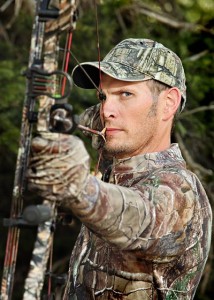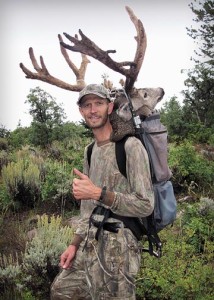Preseason Scouting
Scouting is hunting; it’s not optional. As rule of thumb, you should spend at least twice as much time scouting as you do hunting. With fewer trophy opportunities these days, it’s best to locate big deer and big deer habitat well ahead of hunting season. Simply put, the more days you spend scouting in the preseason, the less time you’ll waste during your hunt.
Scouting doesn’t mean just locating deer, but locating feed and water, bedding areas, escapes routes, game trails, and sign. You don’t have to actually see a big buck to know he’s there; just look for tracks and read the signs.
Multiple Opportunities
Once you’ve located or even patterned a buck, you need to devise multiple game plans. Bowhunting is a low-odds game which means you always need a backup plan, or maybe several. What do you do if you bust the buck on opening morning? Where do you go next? What if that doesn’t work? What if someone else shoots your target buck out from under you?
Effective scouting means always having a backup plan or even a backup buck. Whether I’ve found a great buck, or if I’m just hunting promising new areas, I always have plan A, B, C, D, and so on that will at least cover the first few days of the season.
Part of planning is to anticipate variables, like changing wind direction, and then figuring out the best time of day for a stalk. One method that works for me is to make a list of likely big buck areas and then assign the best time frame to stalk based on thermals, bedding areas, and other factors. For each area I’ll mark morning, evening, or both.
E-Scouting
With modern technology, such as super-optics, trail cameras, GPS with topo maps, and 3D internet mapping, you can now scout anywhere in the country, 365 days a year, even late at night in your underpants.
E-scouting is great for locating promising new country, but nothing beats boots on the ground. Physical scouting accomplishes two important things: first, you’ll become intimately familiar with the terrain you’ll be hunting, and second, you’ll get plenty of pre-hunt exercise while enjoying God’s natural splendors.
Trail Cameras
Trail cameras are a valuable piece of scouting equipment. Not only do cameras tell me when and where the bucks are, but they also tell me where they are not. Any hunter with a limited amount of scouting time will benefit from setting up an array of cameras in likely buck areas.
The best locations to hang cameras are in prime feed locations, secluded water seeps, game trails, bedding routes, and water routes. Even better locations include pinch points, saddles, funnels, and trail intersections. A month or two before the hunt opener I’ll set up four or five cameras covering an area of about five miles. By the hunt opener I have a pretty good idea of the quality and quantity of bucks in my area.
Avoid bumping deer while scouting, especially in the weeks leading up to your hunt. Check your trail cameras during the day when bucks are bedded and less likely to notice you.
Quality Optics
I can’t over-emphasize the importance of quality optics. Binoculars and spotting scopes open up the vastness of the mountain, and quality optics even open up the shadows during the critical morning and evening hours when big bucks are likely to be moving.
The strength of your spotting scope depends on the type of terrain you’ll be hunting. In thick timber country with limited sight distance you’d probably be fine with a 48x, or maybe just 40x binoculars. In this case it’s more important to identify big buck tracks and droppings than to actually see a deer. If you know what you’re looking for, you’ll find the deer.
In open or vast country I would recommend a high-quality, 60-power minimum spotter with a large objective lens that gathers plenty of light early and late in the day. Just beware that spotting scopes in this range can get very pricey and very heavy to pack around.
Where to Look for Big Bucks
When scouting a new mountain, the first step is to locate prime feeding areas. Begin by searching south- and east-facing slopes, especially in areas adjacent to thick timber or steep bedding cover.
East-facing slopes tend to grow better feed than north and western slopes because they get more sun early, and then fall into shade later when the sun is hottest and thus hold more ground water.
Next, look for secluded stands of aspen trees. Aspens only grow where there is an abundance of ground moisture. Not only do deer love to eat aspen leaves, but the myriad of succulent forbs that grow in these areas as well. In the early season, aspen groves provide an ideal bedding area because the ground is cooler. In late fall as bucks get ready to shed their velvet, they spend more time near scrub aspens which they rub their antlers on.
While investigating likely feeding areas, scan the ground continually for large tracks and droppings. Also watch for areas with plenty of chewed-down vegetation. Once you’ve identified prime feed, follow any trails or large deer tracks leading in and out of the area. At the very least, these trails will point to likely bedding areas. Even if you lose the trail, you’ll still get an idea of which direction the deer are coming from or going. Big bucks have relatively small home ranges, so you should have little trouble locating likely bedding areas.
Final Note
It’s always possible that your traditional hunting area will go downhill or be lost to the crowds. So you need to be adaptive and mobile, always searching for promising new areas. If you didn’t draw a tag this year, or you just have extra time on your hands, it’s always a good idea to investigate other units or new areas just to see the potential. You don’t need a tag to scout, so get out there and do some camping and hiking. You never know what you’ll turn up.
Conclusion
Scouting is hunting and should be taken seriously. Just drawing a decent tag is quickly becoming the hardest part of hunting. So when it’s your time and your tag, don’t waste valuable hunting days looking for deer that you could have found during the long preseason months.






















